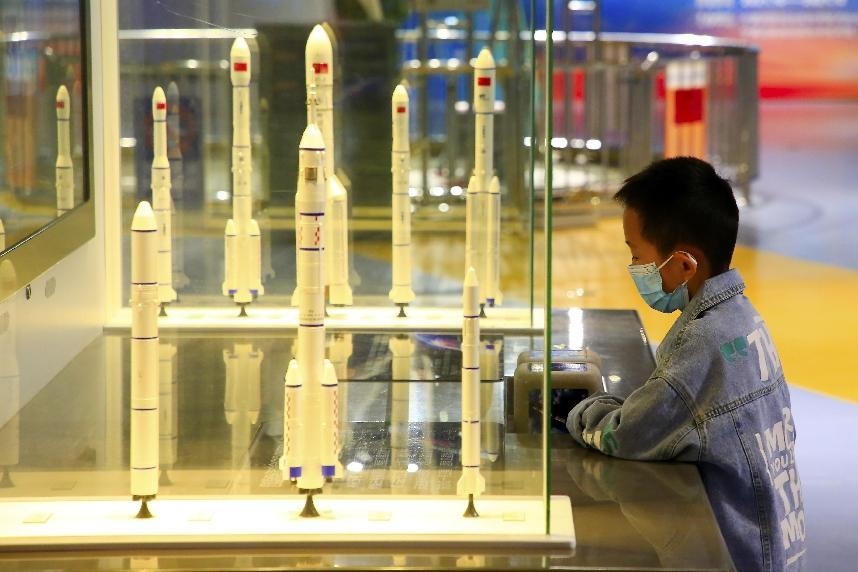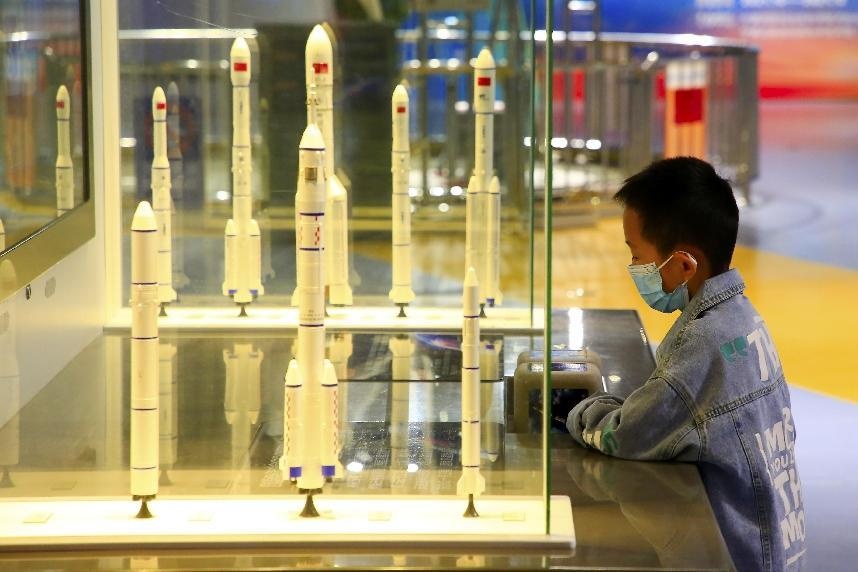By Yu Jianbin, People’s Daily

A child visits an aerospace exhibition at the Ningxia Science and Technology Museum, northwest China's Ningxia Hui autonomous region, April 17, 2022. (Photo by Yuan Hongyan/People’s Daily Online)
Three Chinese astronauts aboard the Shenzhou-13 manned spaceship Zhai Zhigang, Wang Yaping and Ye Guangfu completed their six-month “business trip” to space and returned to Earth on April 16, wrapping up the longest crewed mission to space in China’s aerospace history.
From launching extra-vehicular activities (EVAs) to completing the first autonomous docking between a cargo ship and the core module of the space station, and from witnessing the first spacewalk conducted by a Chinese woman to setting a record for China's crewed space mission duration, the 183-day mission has completed a series of experiments and technological verification, laying a solid foundation for subsequent construction of the space station.
The Shenzhou-13 mission marked a historic transition of China’s aerospace undertaking. The successful mission comprehensively verified the critical technologies required for the construction of the space station and paved a path for subsequent in-orbit assembly and construction.
The three astronauts’ great performance stemmed from the confidence of China’s aerospace industry and the innovation of China’s aerospace technologies.
Wearing China’s independently developed EVA suit Feitian, they calmly completed extra-vehicular activities that were both dangerous and stunning. With a space network that was times faster than 5G, they shared magnificent space views 400 kilometers above the Earth and gave live classes to students.
Previously, Chinese astronauts had to take cargoes and materials in spaceships when leaving the Earth, but the Tianzhou-2 cargo ship acted as a “space courier” this time, delivering materials to the astronauts.
The aerospace progress driven by China’s independent innovation is constantly improving the Chinese people’s ability to enter and exit from the space, and realizing more of their space dreams.
As Wang Yaping encouraged the young generation in a letter she replied to middle school students to build their own “spaceships of dreams” with wisdom and sweats, realizing dreams takes both actions and perseverance.
This year commemorates the 30th anniversary of the establishment of the China’s manned space engineering project. The country’s perseverance in the past three decades will eventually result in the realization of the country’s three-step strategy for manned space program.
In the past 30 years, China’s aerospace industry has made astonishing achievements, such as extending crewed space mission duration from days to half a year and building a spacious and comfortable space station.
What is also noteworthy is China’s efforts to continuously implement its aerospace strategies. Chinese aerospace personnel have made stable progress and led the country to an era of space station. The achievements nowadays are rewards of their perseverance.
As an important indicator of national sci-tech level and capability, Chinese aerospace has achieved considerable strides toward sci-tech independence with self-confidence and self-reliance, significantly inspiring the society to make further innovations.
The cosmos is immense and exploration of it will never be completed. The construction of the space station is an important milestone of China’s aerospace undertaking and will make groundbreaking contributions to mankind’s peaceful exploitation of space.
This year will be a year of decisive victory for the construction of the space station. The in-orbit construction of the space station remains arduous, and the building of a stable in-orbit national space lab still confronts obstacles.
It is believed that Chinese astronauts will explore the universe with more confidence and the Chinese people will undoubtedly have more profound knowledge of the enormous space.
From launching extra-vehicular activities (EVAs) to completing the first autonomous docking between a cargo ship and the core module of the space station, and from witnessing the first spacewalk conducted by a Chinese woman to setting a record for China's crewed space mission duration, the 183-day mission has completed a series of experiments and technological verification, laying a solid foundation for subsequent construction of the space station.
The Shenzhou-13 mission marked a historic transition of China’s aerospace undertaking. The successful mission comprehensively verified the critical technologies required for the construction of the space station and paved a path for subsequent in-orbit assembly and construction.
The three astronauts’ great performance stemmed from the confidence of China’s aerospace industry and the innovation of China’s aerospace technologies.
Wearing China’s independently developed EVA suit Feitian, they calmly completed extra-vehicular activities that were both dangerous and stunning. With a space network that was times faster than 5G, they shared magnificent space views 400 kilometers above the Earth and gave live classes to students.
Previously, Chinese astronauts had to take cargoes and materials in spaceships when leaving the Earth, but the Tianzhou-2 cargo ship acted as a “space courier” this time, delivering materials to the astronauts.
The aerospace progress driven by China’s independent innovation is constantly improving the Chinese people’s ability to enter and exit from the space, and realizing more of their space dreams.
As Wang Yaping encouraged the young generation in a letter she replied to middle school students to build their own “spaceships of dreams” with wisdom and sweats, realizing dreams takes both actions and perseverance.
This year commemorates the 30th anniversary of the establishment of the China’s manned space engineering project. The country’s perseverance in the past three decades will eventually result in the realization of the country’s three-step strategy for manned space program.
In the past 30 years, China’s aerospace industry has made astonishing achievements, such as extending crewed space mission duration from days to half a year and building a spacious and comfortable space station.
What is also noteworthy is China’s efforts to continuously implement its aerospace strategies. Chinese aerospace personnel have made stable progress and led the country to an era of space station. The achievements nowadays are rewards of their perseverance.
As an important indicator of national sci-tech level and capability, Chinese aerospace has achieved considerable strides toward sci-tech independence with self-confidence and self-reliance, significantly inspiring the society to make further innovations.
The cosmos is immense and exploration of it will never be completed. The construction of the space station is an important milestone of China’s aerospace undertaking and will make groundbreaking contributions to mankind’s peaceful exploitation of space.
This year will be a year of decisive victory for the construction of the space station. The in-orbit construction of the space station remains arduous, and the building of a stable in-orbit national space lab still confronts obstacles.
It is believed that Chinese astronauts will explore the universe with more confidence and the Chinese people will undoubtedly have more profound knowledge of the enormous space.
 Menu
Menu
 China gains more confidence in understanding universe
China gains more confidence in understanding universe
















